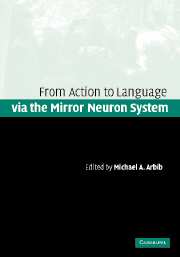Preface
Published online by Cambridge University Press: 01 September 2009
Summary
There are many ways to approach human language – as a rich human social activity, as a formal system structured by rules of grammar, and as a pattern of perception and production of utterances, to name just a few. The present volume uses this last concern – with the perception and production of utterances – as its core. The aim is not to ignore the other dimensions of language but rather to enrich them by seeking to understand how the use of language may be situated with respect to other systems for action and perception.
The work is centered on, but in no way restricted to, the Mirror System Hypothesis (introduced by Arbib and Rizzolatti in 1997). This is the hypothesis that the mirror neuron system for the recognition of movements of the hands in praxic action – which is present both in monkey and in human in a number of areas including Broca's area (generally considered to be the frontal speech area) – provides the evolutionary basis for the brain mechanisms which support language. The Mirror System Hypothesis sees the ancestral action recognition system being elaborated through the evolution of ever more capable neural mechanisms supporting imitation of hand movements, then pantomime emerging on the basis of displacement of hand movements to imitate other degrees of freedom. A system of “protosign” emerges as conventionalized codes extend the range of manual communication, and serves as scaffolding for “protospeech.”
- Type
- Chapter
- Information
- Action to Language via the Mirror Neuron System , pp. ix - xivPublisher: Cambridge University PressPrint publication year: 2006

